CVA - Unit 1. Vertebrate History and Lineages
1/106
There's no tags or description
Looks like no tags are added yet.
Name | Mastery | Learn | Test | Matching | Spaced |
|---|
No study sessions yet.
107 Terms
Phylogeny
the evolutionary history of lineages
Ontogeny
the development of individuals
Metamerism
segmentation of body structures (along the anteroposterior axis)
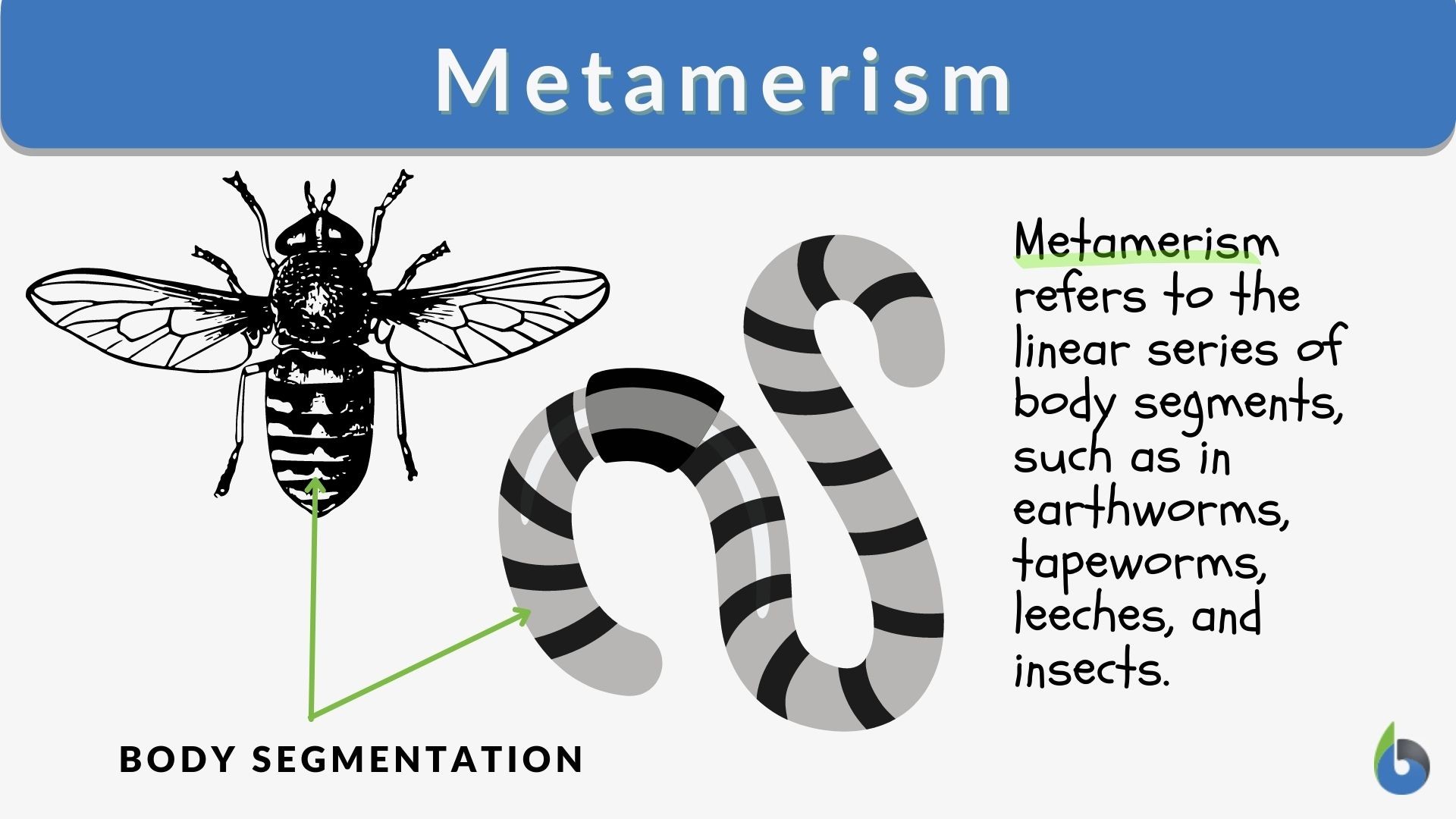
Bilateral symmetry
distinct anterior / posterior regions; midsagittal plane can divide the body into mirrored halves
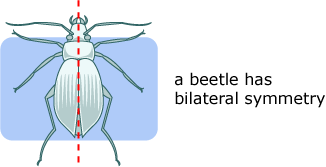
Cephalization
the increased localization of nerves and sensory structures into a distinct, dominant head
Adaptation
a hereditary modification of a phenotype that increases the probability of survival
Preadaptation
structure or behavior possesses the necessary form or function before the biological role arises
Morphologies can be similar based on which three criteria?
Homology
Analogy
Homoplasy
Homology
similarity based on common ancestry (often detected via embryology)
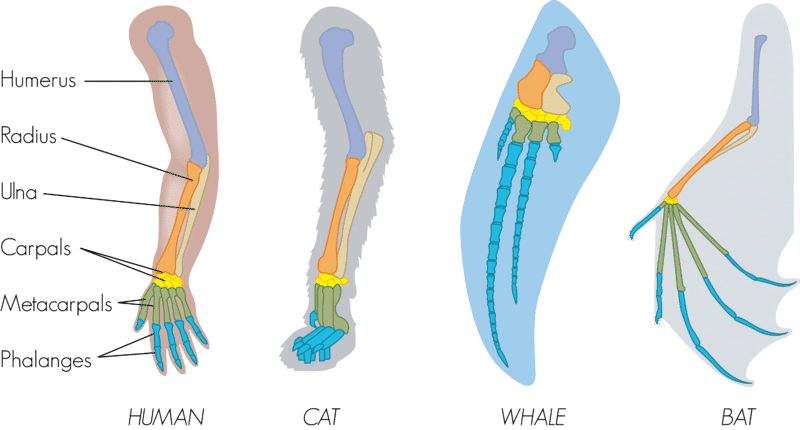
Analogy
similarity of function
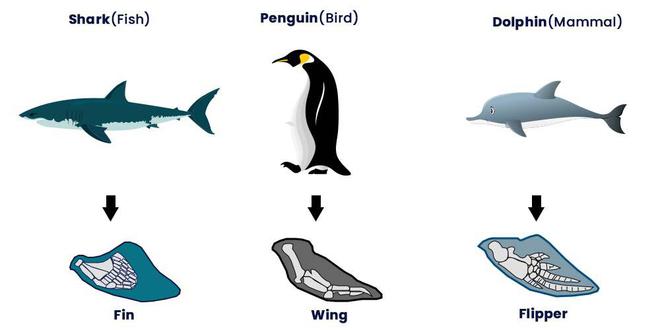
Homoplasy
similarity of resemblance (usually refers to similarities in structure that do NOT result from common evolutionary origin)
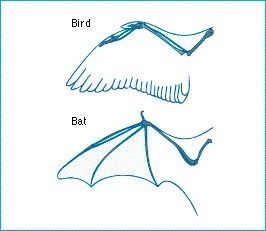
_______ and ______ evolution often lead to homoplasy.
Convergent, parallel
Parallelism
closely related species that diverged relatively recently develop similar specializations
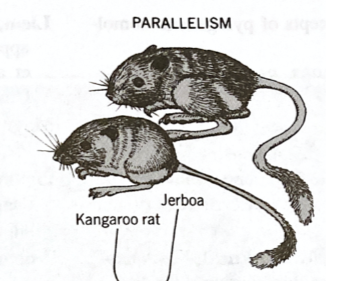
Convergent evolution (convergence)
distantly related and morphologically dissimilar species become more similar in descendants
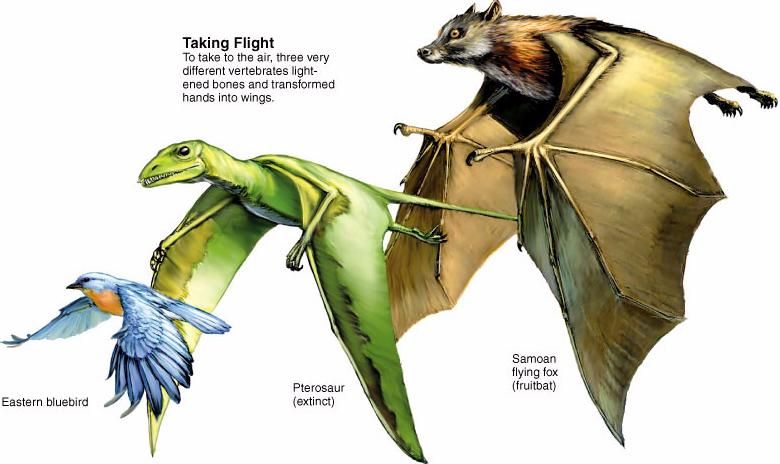
Heterochrony
changes in the relative timing of developmental processes in descendants relative to ancestral species
Paedomorphosis
retention of embryonic or larval characteristics into adulthood
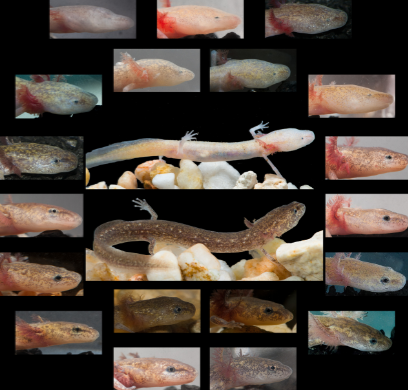
Peramorphosis
development of structures is extended, creating new morphologies
Clade
all the descendants of a common ancestor
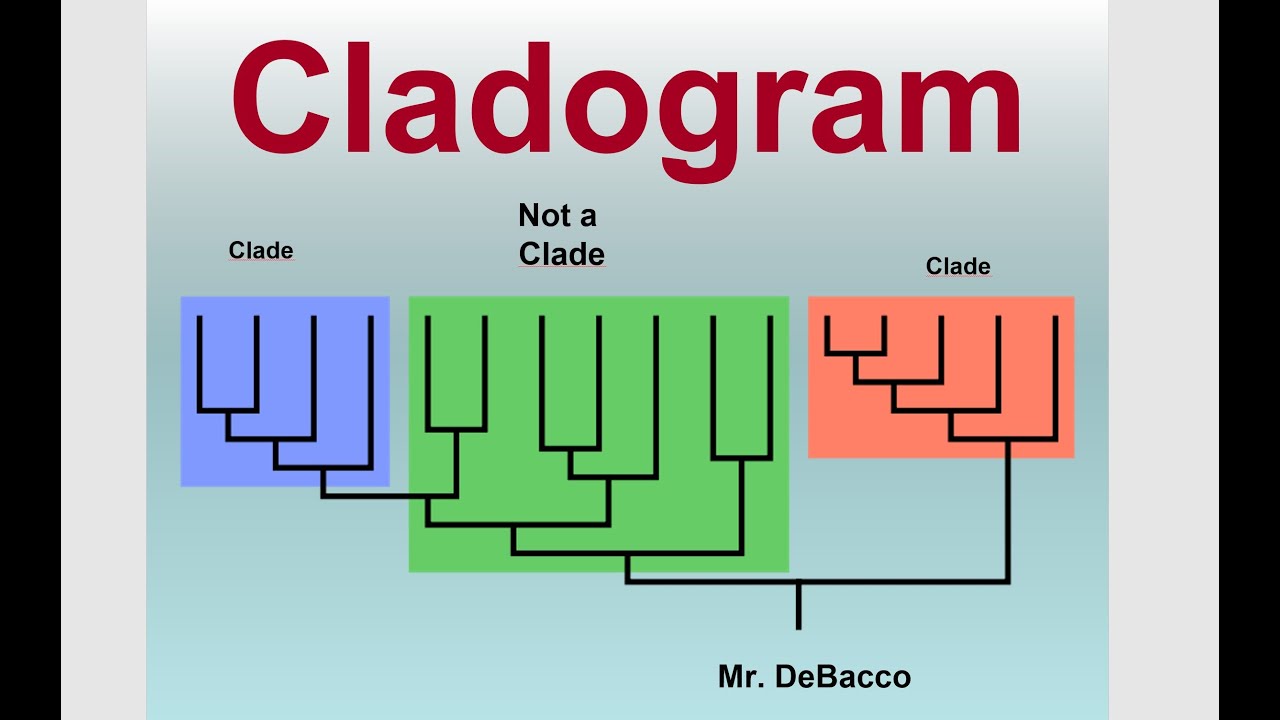
Non-rank nomenclature
names assigned to lineages originating from each branch point (node)
Plesiomorphic traits
ancestral (“primitive”) traits
Symplesiomorphy
shared ancestral characteristics
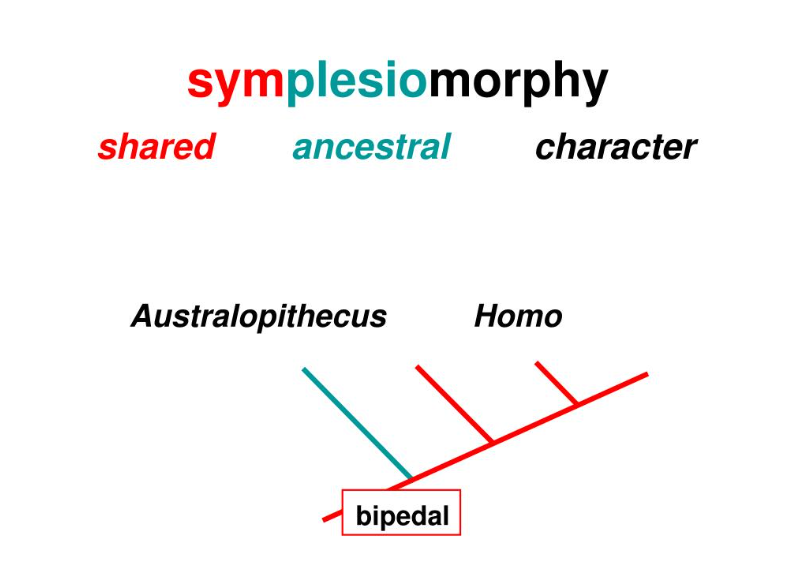
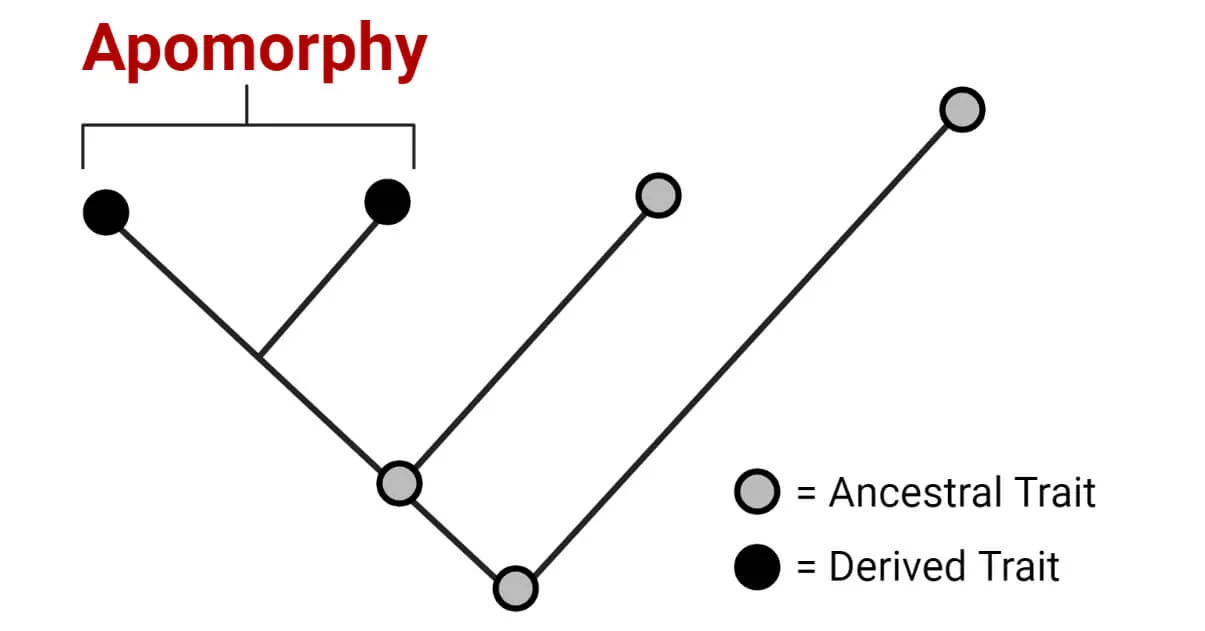
Apomorphic traits
derived traits
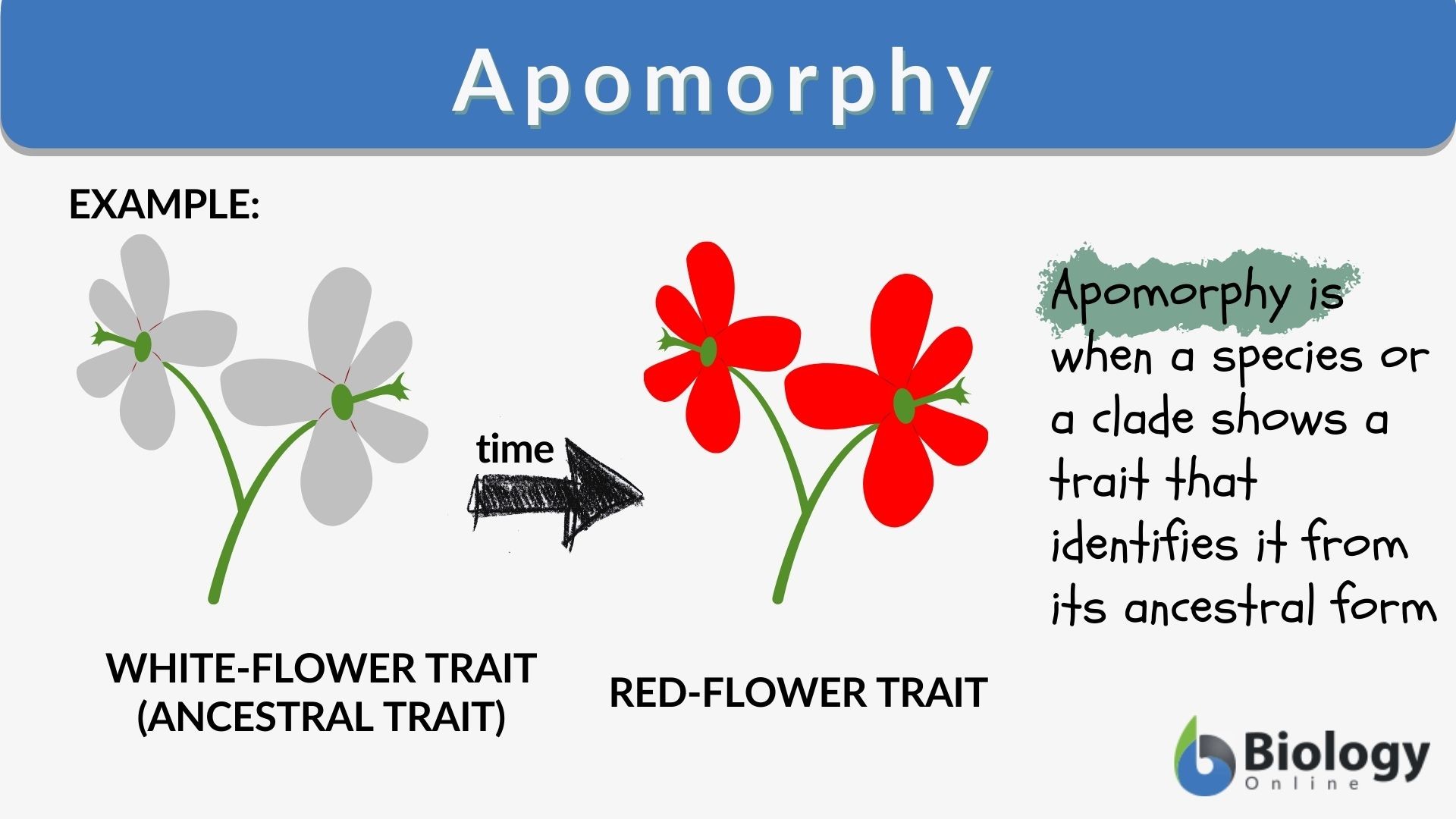
Autapomorphy
unique derived characteristics
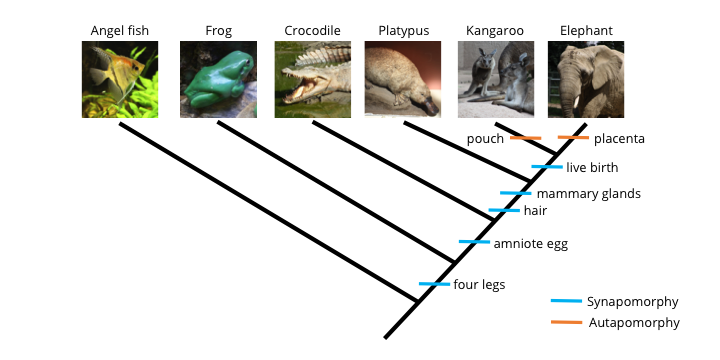
Synapomorphy
shared derived characteristics
(These are the ONLY traits that provide information re: phylogenetic relationships)
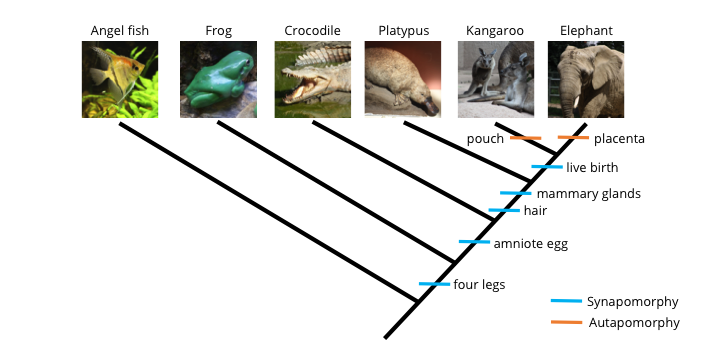
Parsimony
tendency towards the simplest explanation (“Occam’s razor”)
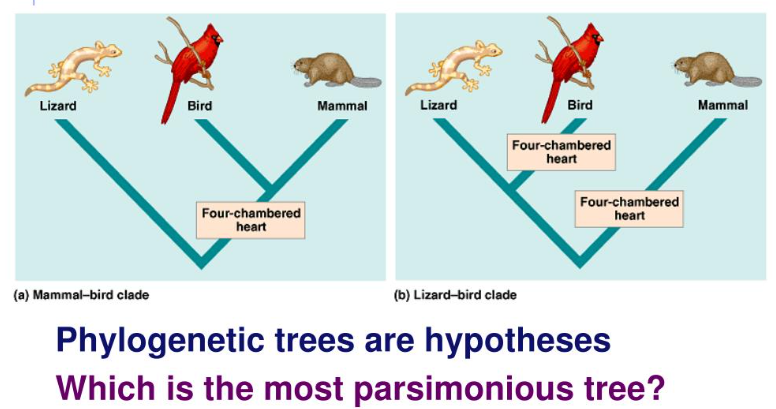
Principle of parsimony
fewest number of changes from ancestral to derived trait is most parsimonious
Monophyletic group
ALL descendants of a common ancestor are included
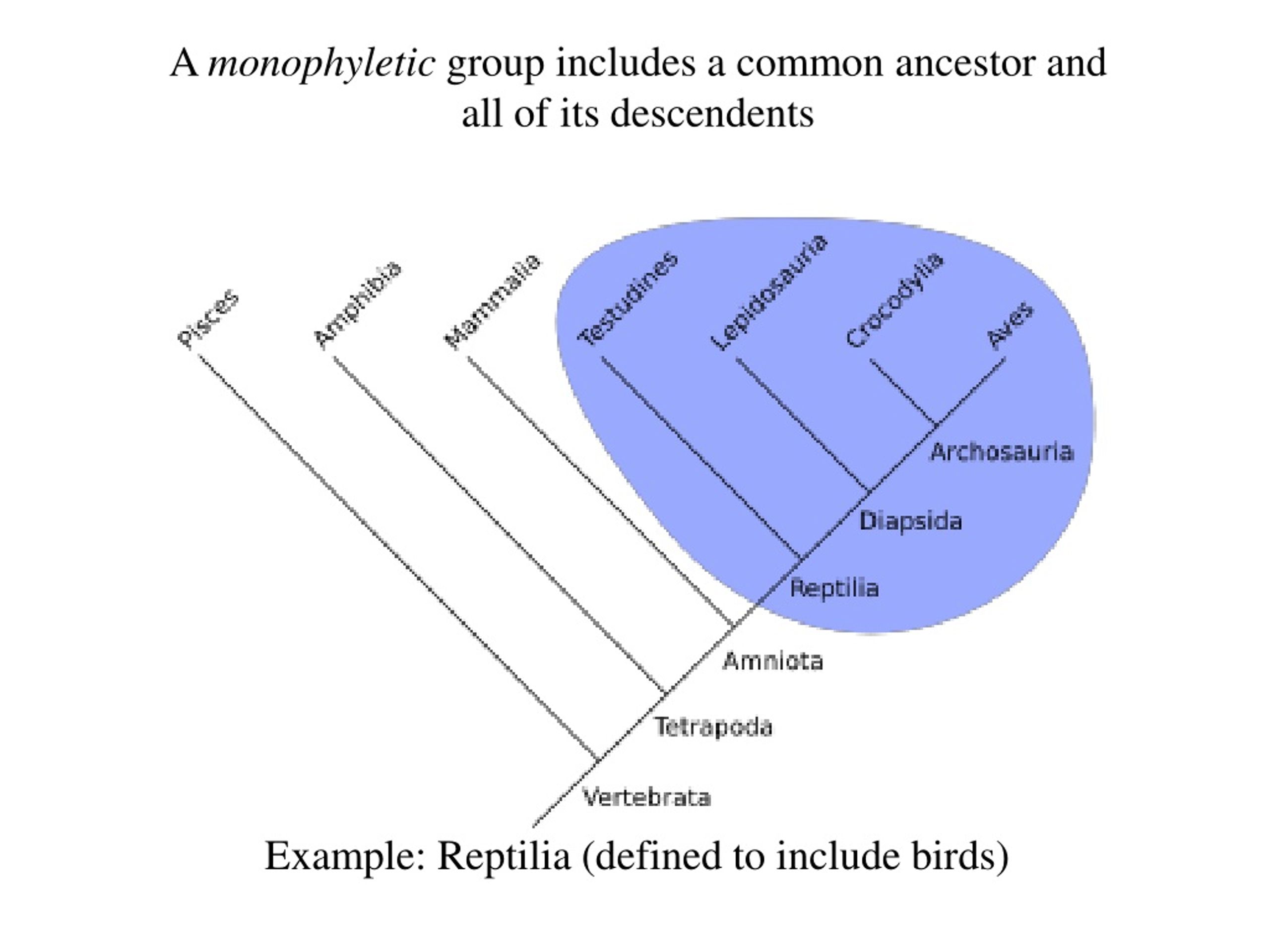
Paraphyletic group
includes common ancestor, but one or more descendants are omitted
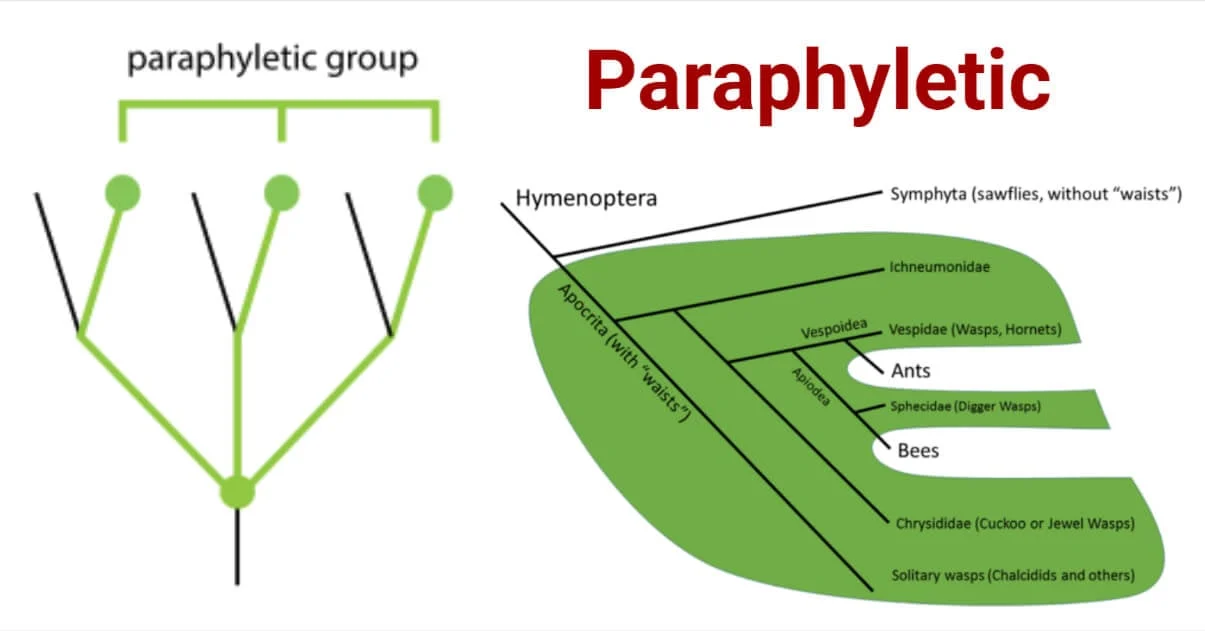
Polyphyletic group
members do NOT share a common ancestor
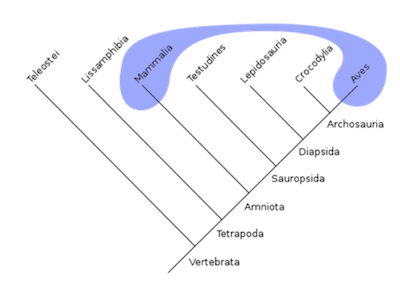
Crown group
smallest clade that includes ALL living members of a group and any fossils (usually the top of the phylogenetic tree)
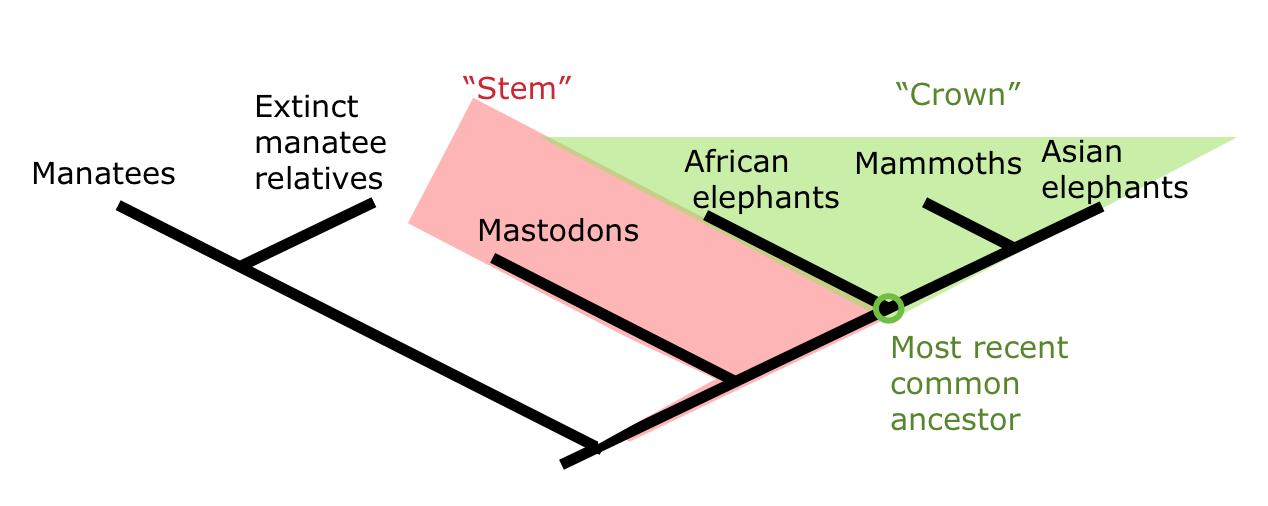
Stem group
extinct basal members of a clade not included in the crown group, (often lacking some synapomorphies) but are more closely related to the crown group than any other group
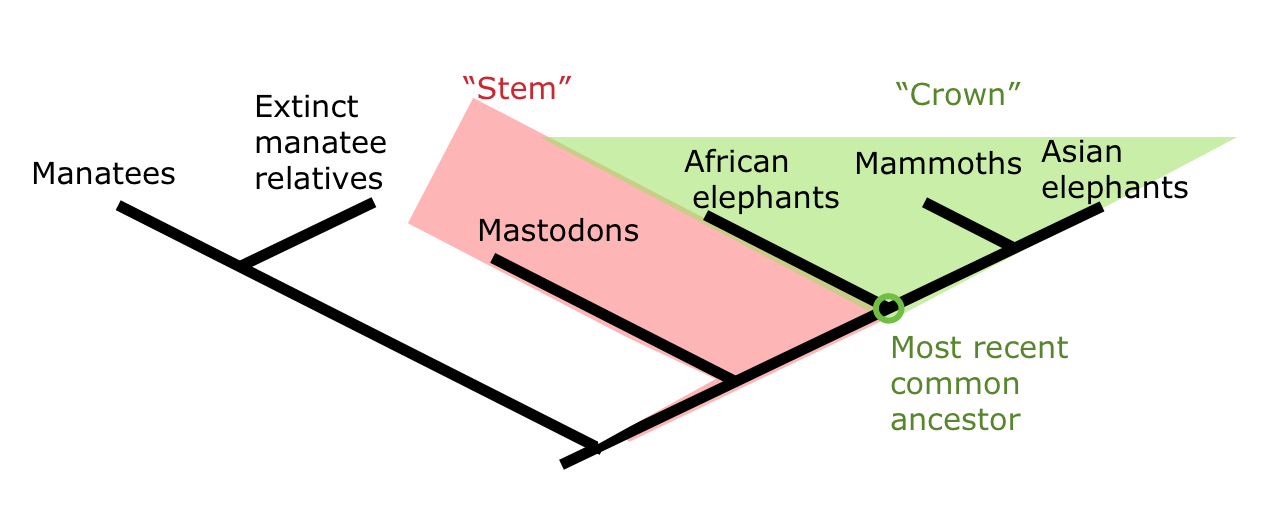
Why can phylogenies be considered “hypotheses”?
They are based on incomplete data and are subject to change with new evidence.
Remember: The fossil record is NOT complete. It takes a while to become a fossil. The information we have today could change tomorrow!
Why can traits be considered primitive, but not living organisms?
Organismal phenotypes are often a mosaic, or a mishmash, of ancestral and derived traits. We can use “primitive” or “ancestral” to describe the traits, but not the living organism.
A simple mono/pary/polyphyly diagram. :)
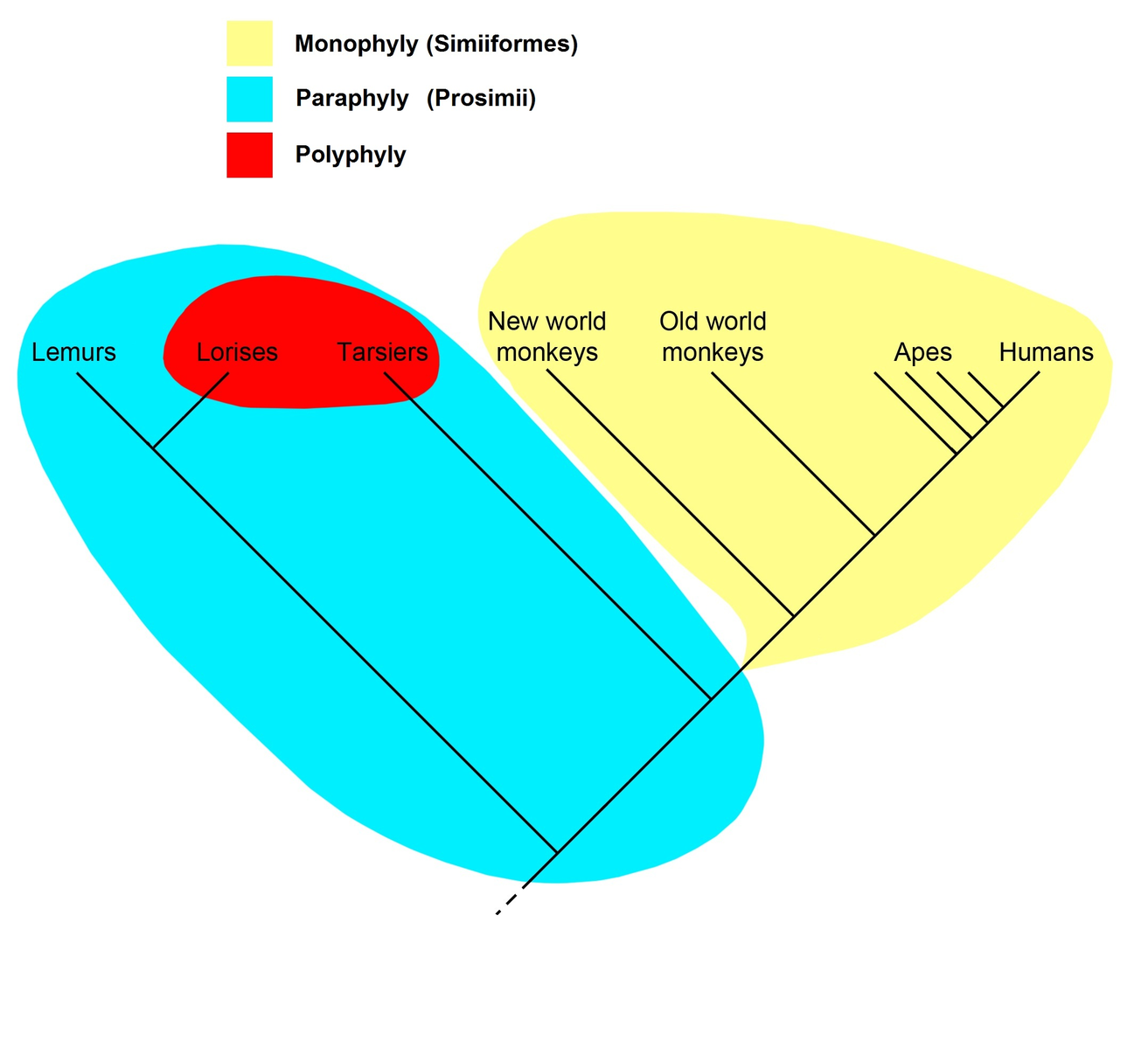
True or False: By definition, crown groups are considered paraphyletic.
False
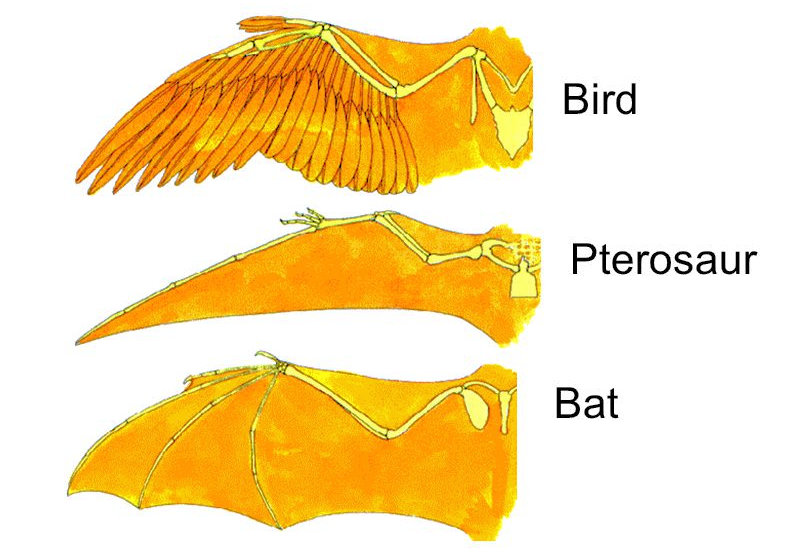
The airfoils of pterosaurs and bats are _____ as wings, but _____ as forelimbs.
analogous, homoplastic
Vertebrates are metazoans. Metazoan is just a fancy word for saying…
animal
What are some key features that all metazoans share?
Multicellular - allows for division of labor and cell specialization
Heterotrophic
Eukaryotic
Motile for at least part of life cycle
Sexual reproduction (mostly)
Embryonic development
Exhibit some form of body symmetry
Have body plans with germ layers
Heterotrophy(ic)
does not make its own food; obtains energy by eating other organisms or organic matter
What are metazoans thought to have evolved from?
Colonial choanoflagellates
(These resemble the choanocytes, or goblet cells, found in sponges.)
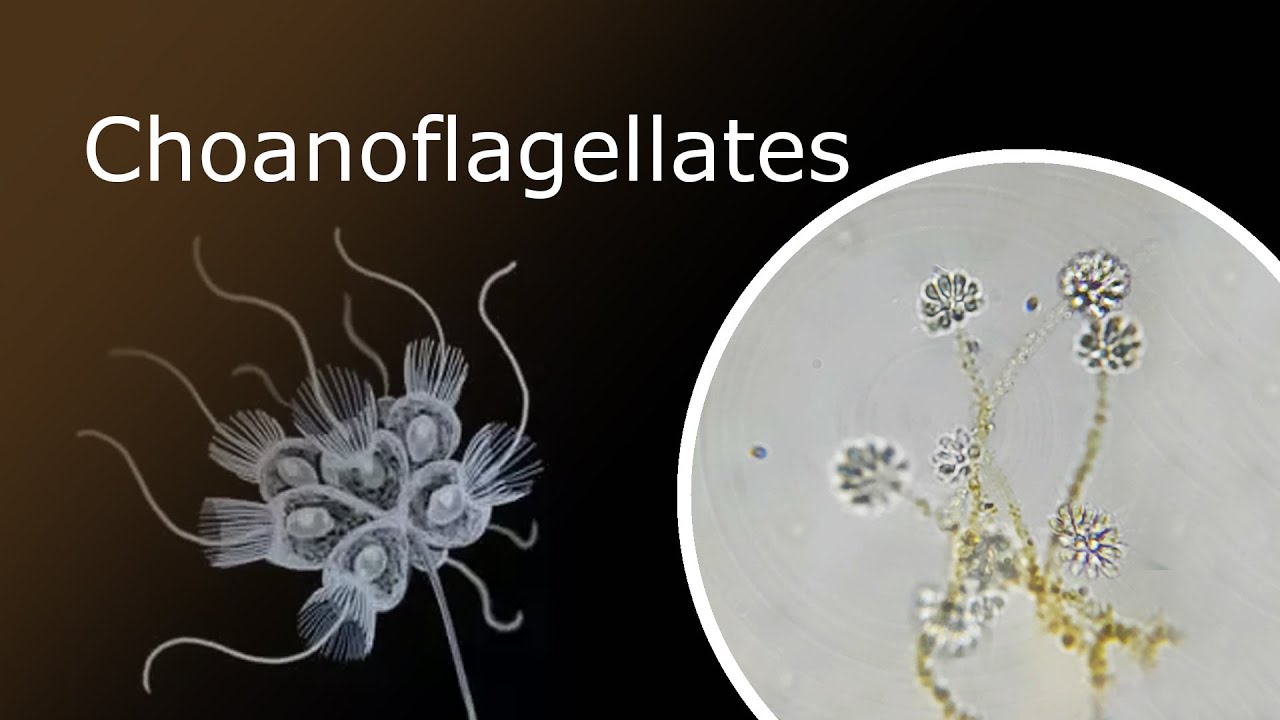
List the key features of deuterostome development.
Anus forms first
Radial cleavage
Coelom forms from mesodermal pouches extending off of the gut (enterocoely)
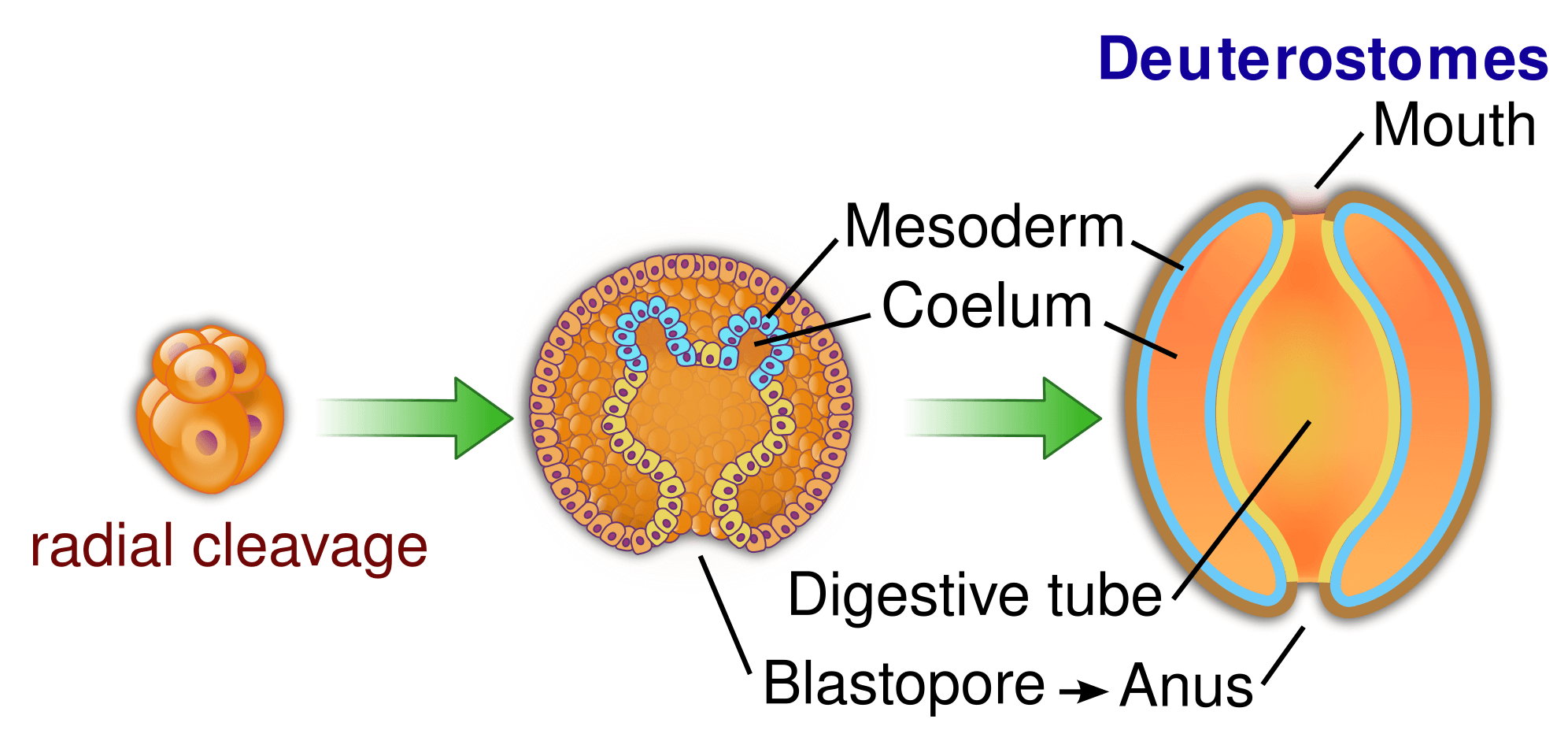
List the key features of protostome development.
Mouth forms first, at or near blastopore
Spiral cleavage
Mesoderm forms as a block of tissue and will eventually split to become the coelom (schizocoely)
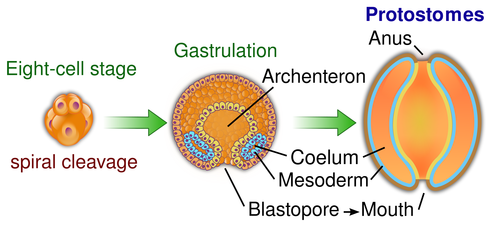
What are two major protostome lineages discussed in class?
Ecdysozoans (ex. arthropods, nematodes)
Lophotrochozoans (ex. mollusks)

What are two major deuterostome lineages discussed in class?
Ambulacrarians (ex. echinoderms, acorn worms)
Chordates (ex. lancelets, tunicates, vertebrates)
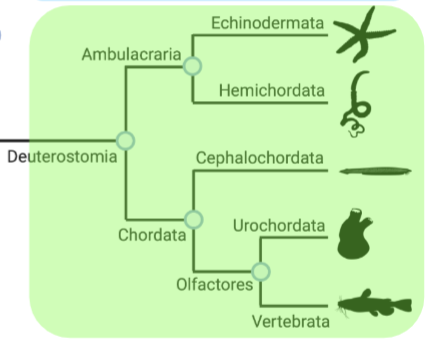
Pharyngotremy
“perforated pharynx”
(A series of pharyngeal pouches arises as
diverticula of the endoderm of the foregut on
either side of the pharynx. These become the
arches, which form supporting structures of
soft and skeletal tissues. Between pouches are cleft-like depressions, or pharyngeal clefts, which may rupture to
form slits and provide passage from the
pharynx to the outside.)
Why is pharyngotremy vital to aquatic vertebrates?
The resulting arches and clefts become persistent gill slits that pass water into the pharynx, both for filter feeding and respiration.
Why is pharyngotremy vital to terrestrial vertebrates?
Each arch has a cartilaginous and muscular component, an artery, and a cranial nerve. The arches contribute to a variety of glands, lymphatic tissues, bones, nerves, throat muscles, and heads of tetrapods.

True or False: Convergent evolution is the phenomenon where closely related species develop similar morphologies.
False
Which of the following is best defined as 'ancestral trait'?
plesiomorphy
autapomorphy
apomorphy
synapomorphy
plesiomorphy
True or False: By definition, crown groups are paraphyletic.
False
True or False: Nonvertebrate chordates have filamentous gill tissue on the pharyngeal arches.
False
From which pharyngeal arch is the facial nerve derived?
Arch 2
Which cell type is unique to cnidarians?
Cnidocytes
‘Ammocoetes’ refers to the larval form of which group?
Petromyzontiformes
In which group do we see the earliest appearance of mineralized tissues?
Conodonta
True or False: The tongue is innervated by the hypoglossal nerve in Gnathostomes.
True
The cartilaginous element that contributes to the upper jaw of gnathostomes is the __________.
palatoquadrate
The cartilaginous element that contributes to the lower jaw of gnathostomes is the _____.
Meckel's cartilage
What 4 features do all chordates share?
Dorsal hollow nerve cord (forms CNS)
Notochord (slender rod of fibrous connective tissue lying beneath and parallel to central nerve cord)
Endostyle (homologous with thyroid gland)
Postanal tail (posterior elongation of the body)
Pharyngeal bars and slits are vital to nonvertebrate chordates because they are primarily involved in…
filter feeding
True or False: All chordates have muscular segments called myomeres.
True
What are the 3 subphylums of Phylum Chordata?
Cephalochordata
Urochordata
Vertebrata
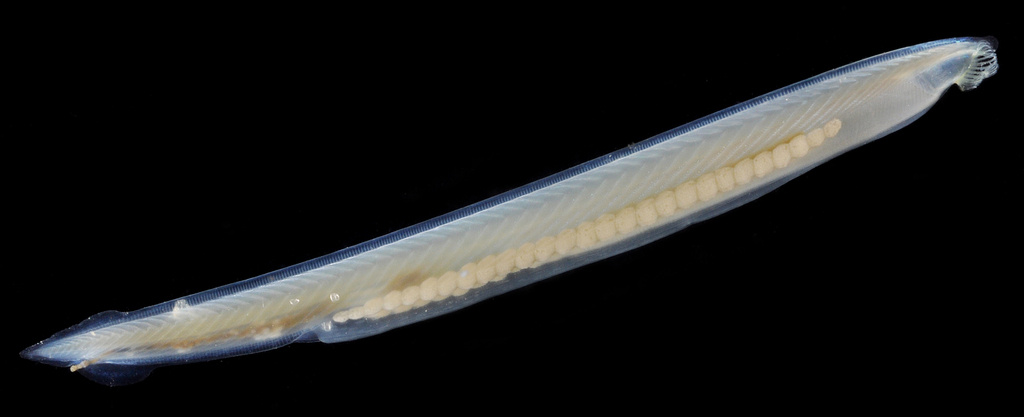
Subphylum Cephalochordata
Marine chordates known for burrowing into sandy sediments
Filter feed via buccal cirri and wheel organ
Water flows over ciliated pharyngeal bars, exits into atrium or tunic, and goes out through atriopore
Ciliated neurula embryo
Ex. Amphioxus, lancelets
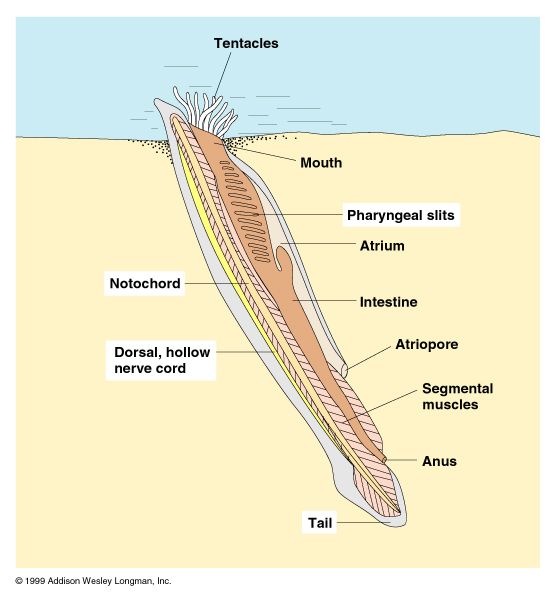
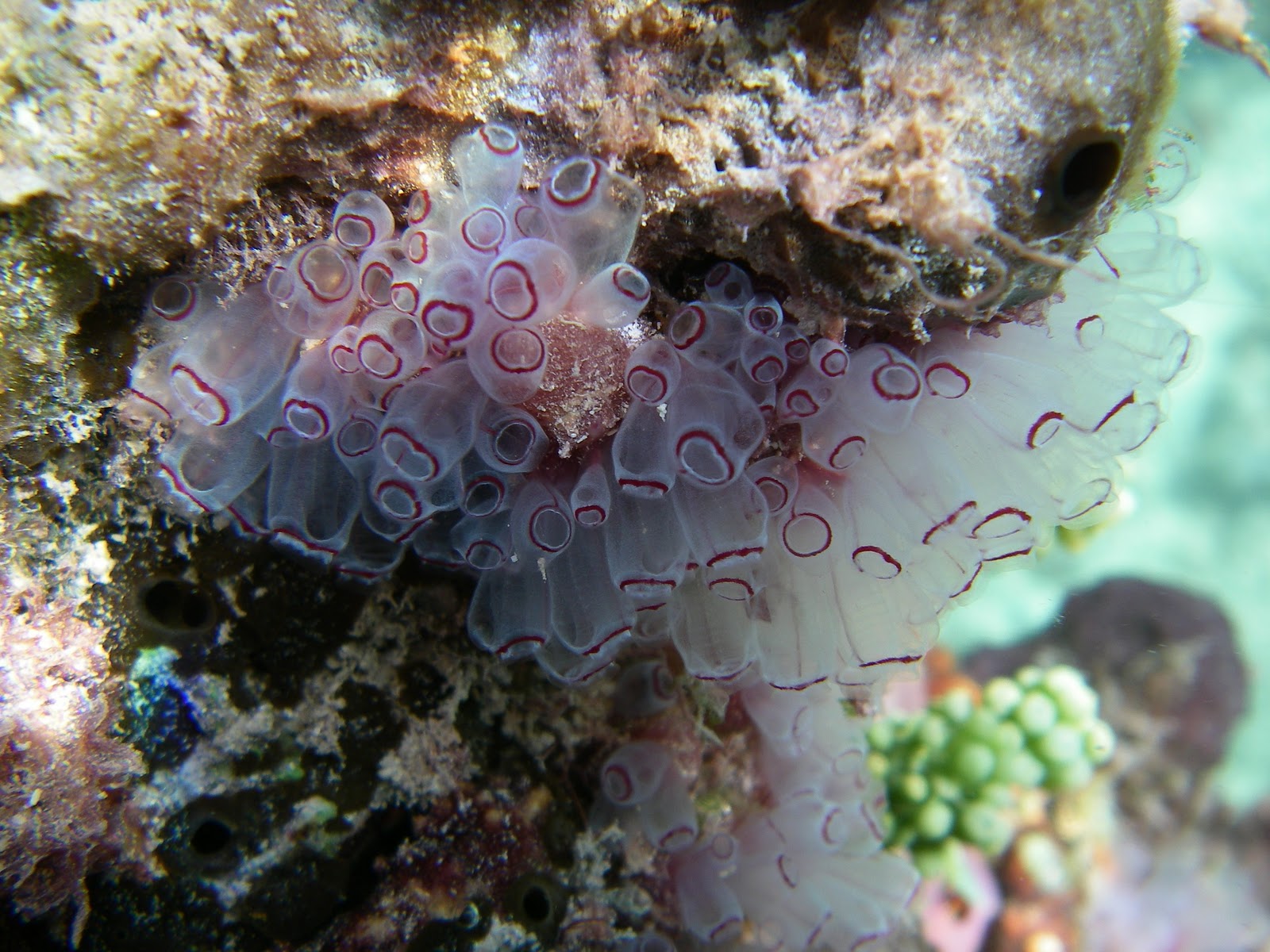
Subphylum Urochordata
Sessile adults with saclike bodies and tubular in/excurrent siphons
Encased in a protective, supportive tunic that is secreted by the epidermis of the mantle
Free-swimming “ascidian tadpole” larvae (CNS degenerates at metamorphosis, tail and notochord are resorbed)
Ex. Tunicates, sea squirts
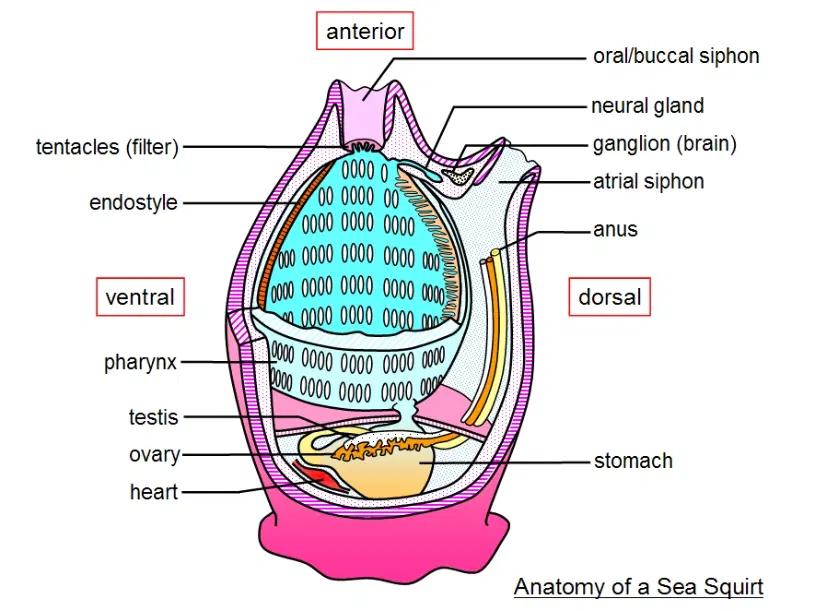
What are the MAJOR derived anatomical traits shared by vertebrates?
Vertebral column
Cranium
Forebrain (specifically the telencephalon)
Closed circulatory system
Complete digestive tract
Multilayered epidermis
Pancreas and liver
Cyclostomes - Myxiniformes
Hagfishes
Marine, burrowing scavengers
Large mucus glands, internal gill openings, and a single terminal nasal opening
Barbels around mouth
“Tooth plates”
Large blood sinuses and low blood pressure
Exhibit a “knotting” behavior
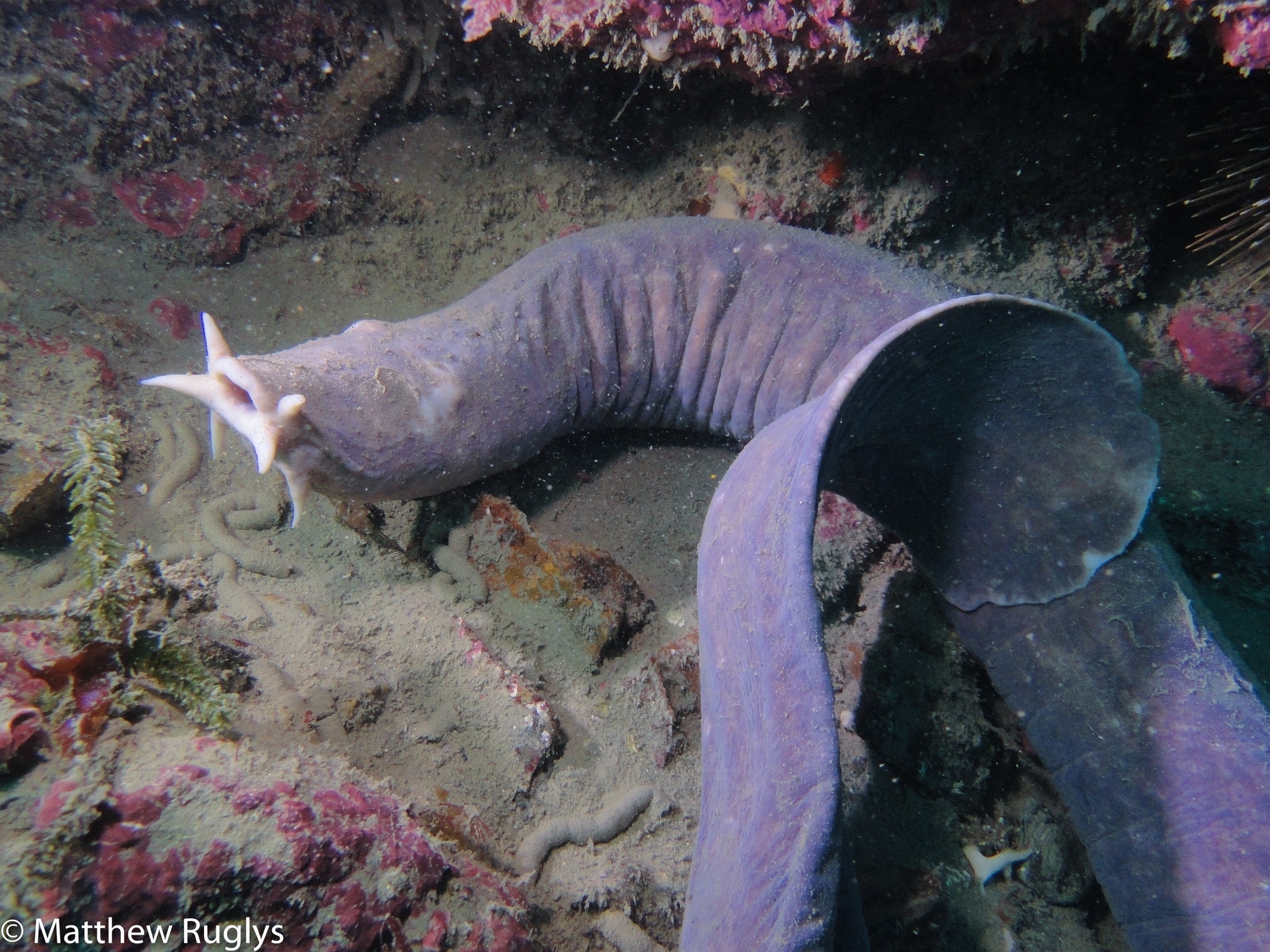
Cyclostomes - Petromyzontiformes
Lampreys
Single nasal opening on top of head
Heart innervated by Vagus nerve
Parasitic as adults; oral gland secretes anticoagulant
Anadromous - ascend rivers and streams to spawn and then die afterward
Spends most of life cycle as ammocoetes larvae, which burrow into sediment and suspension-feed
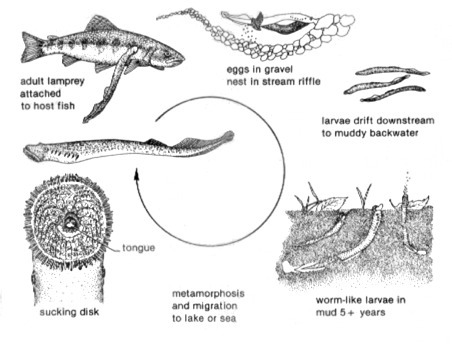
Which of the following is not a shared derived trait for Gnathostomata?
Paired pelvic fins
Branchiomeric musculature
3 semicircular canals in inner ear
Hypobranchial musculature
Branchiomeric musculature
Describe the structure of the dermal armor of ostracoderms.
Made up of aggregations of odontodes - toothlike elements in the dermis - and projections of dentine with pulp cavity and a bony base (aspidin)
Very similar to the placoid scales of sharks
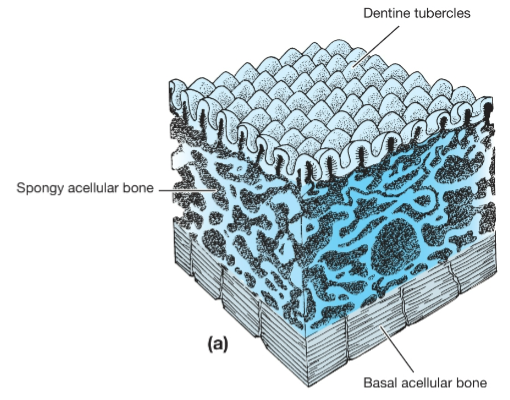
Why was mineralized tissue an important radiation of early vertebrates?
It offered the basis for advanced body armor for protection, teeth for predation, and an endoskeleton for locomotion
Pectoral fins and girdles first arose in…
osteotracans
Jaws are derived from an enlarged, anterior pharyngeal arch called the…
Mandibular arch
Why did jaws in organisms likely evolve?
Initially to increase efficiency of gill ventilation, and later coopted for predation
How did jaws likely evolve?
From pharyngeal slits and branchial arches
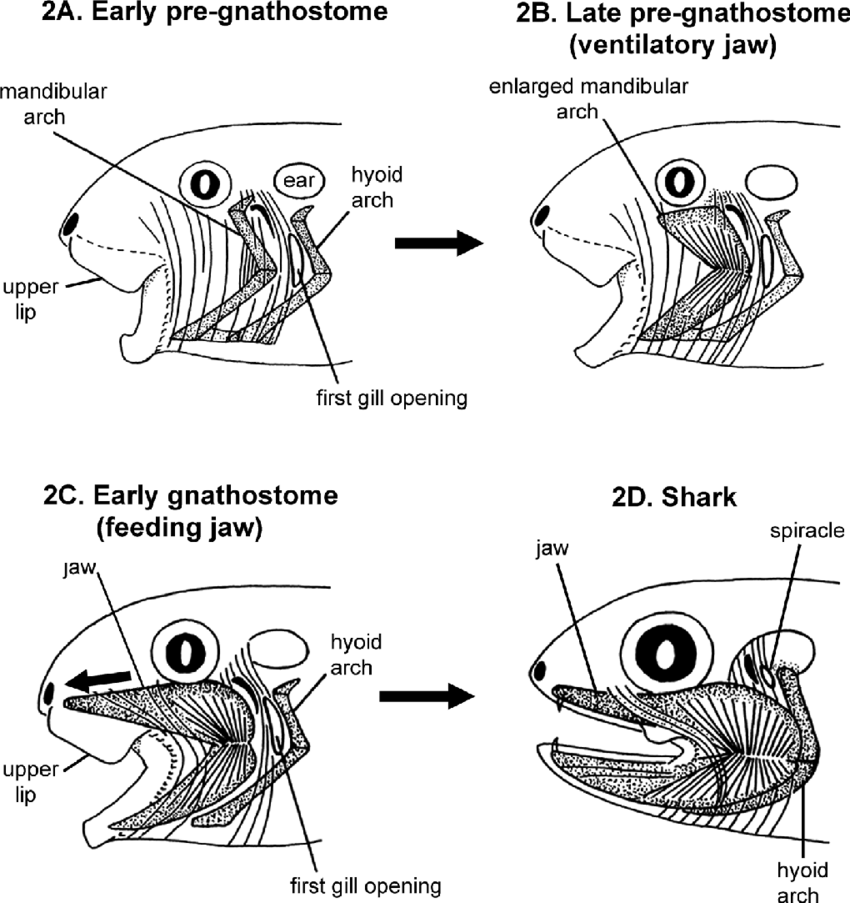
List the generalized body plan features of Gnathostomes.
Jaws formed from mandibular arch
Gill skeleton of jointed branchial arches with rakers
Hypobranchial muscles
2 olfactory tracts and nostrils
Spiracle
3 semi-circular inner ear canals
Conus arteriosus of the heart
Horizontal septum
Vertebrae with centrum and ribs
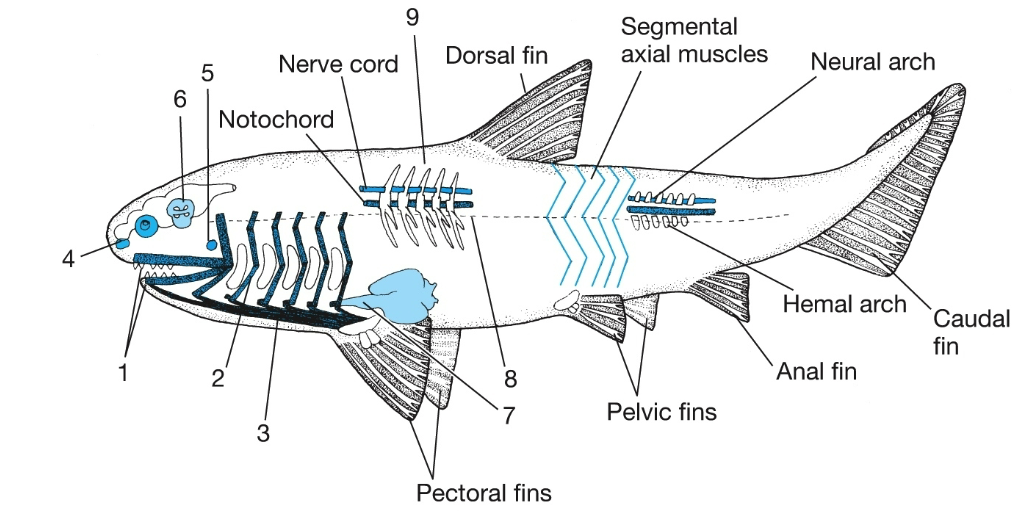
Placoderms
Extinct sister group to Gnathostomes
Extremely diverse in size and morphology
Thick bony shield of dermal armor on head, front of body, and pectoral fins
Most lacked teeth, but had toothlike projections of the dermal jawbones
Mineralized endoskeletons
Some of the earliest known instances of viviparity (developing embryos) in vertebrates
Ex. Dunkleosteus
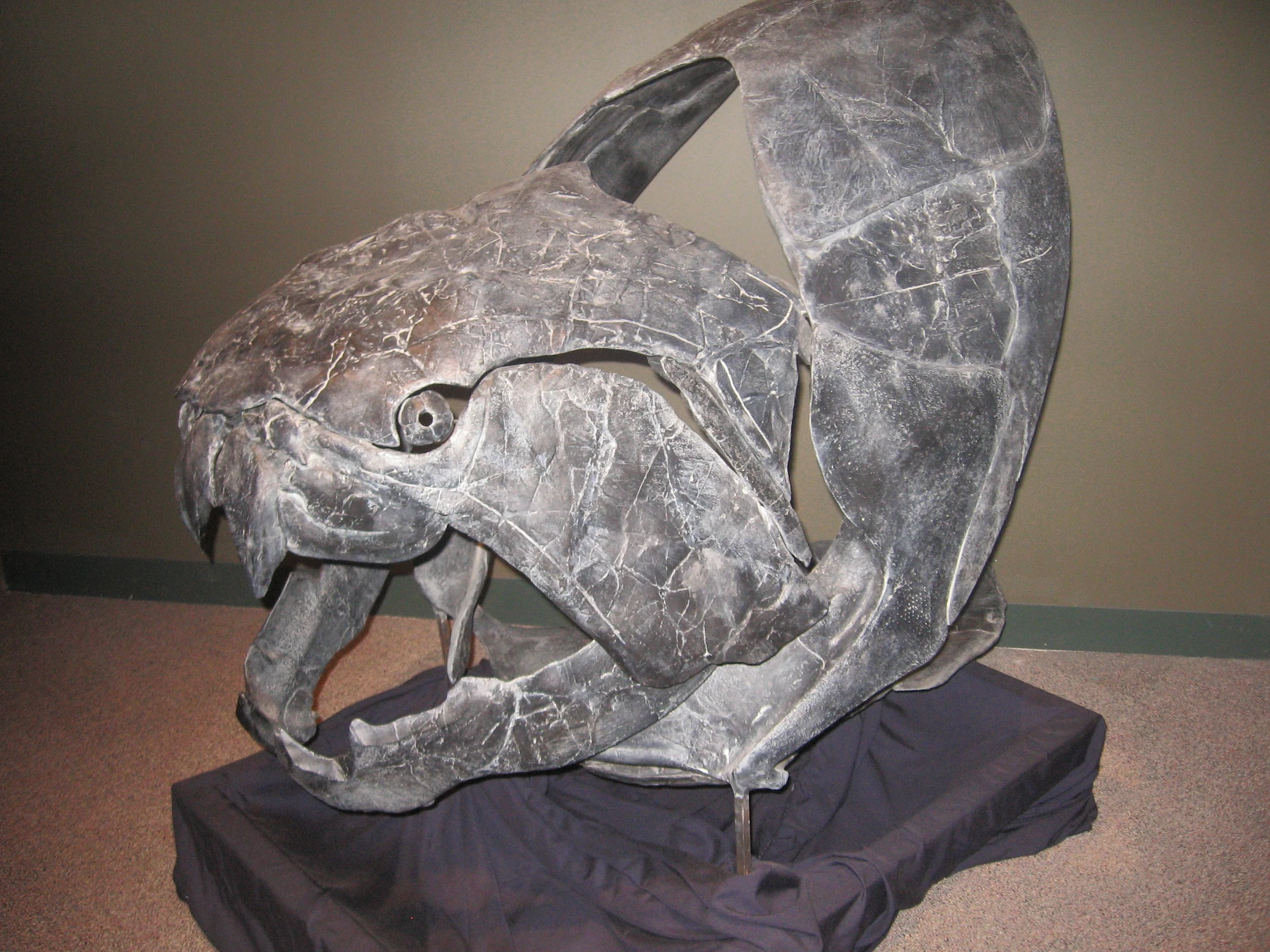
Acanthodians
Extinct
Most the size of minnows
Heterocercal tail
Teeth formed shark-like tooth whorl
Primitive, large operculum-covered gills
“Spiny sharks”
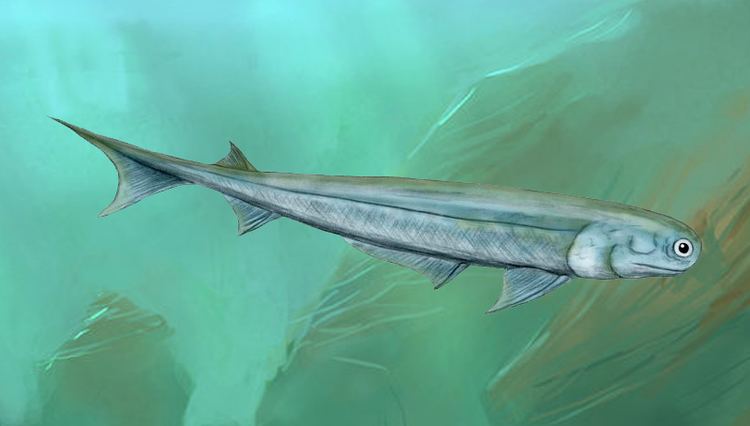
Almost half of all vertebrates can be split in terms of diversity between ___________ (ray-finned) and ___________ (lobe-finned, including tetrapods).
Actinopterygii, Sarcopterygii
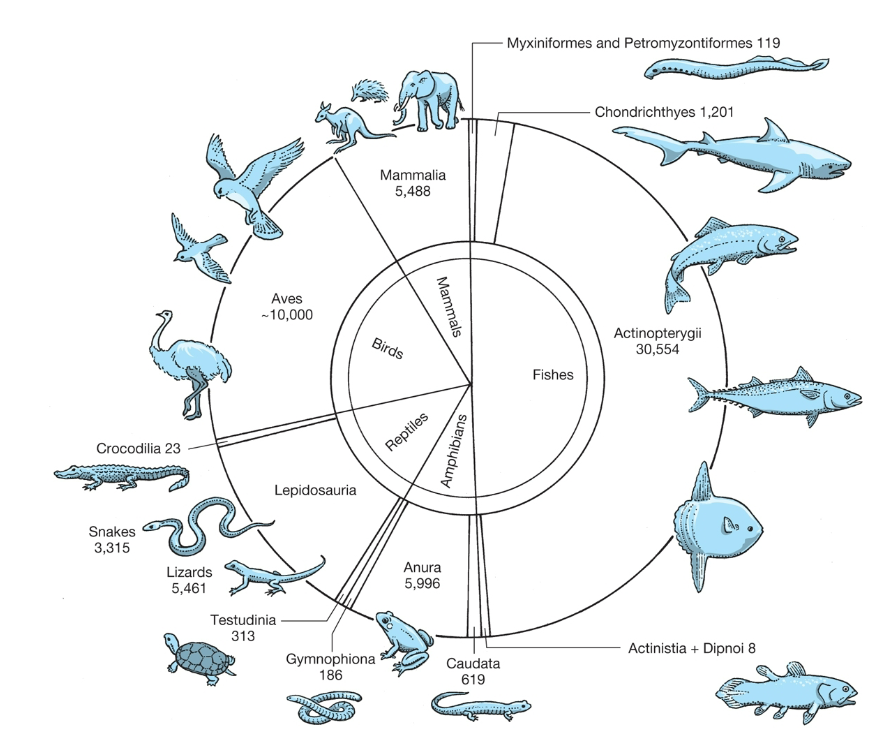
What are some major shared characteristics of all Chondrichthyes?
“Oily” liver
Ampullae of Lorenzini
Cartilaginous skeletons
Placoid scales
Reproductive claspers in males
Subterminal mouths
Continuous tooth replacement
What two major groups comprise the Chondrichthyes?
Elasmobranchii (sharks and rays)
Holocephali (chimaeras or ratfishes)
Chondrichthyes - Elasmobranchii
Sharks (Selachii) and skates and rays (Batoidea)
5 exposed gill slits
Small or absent dorsal spiracle (often closes before birth)
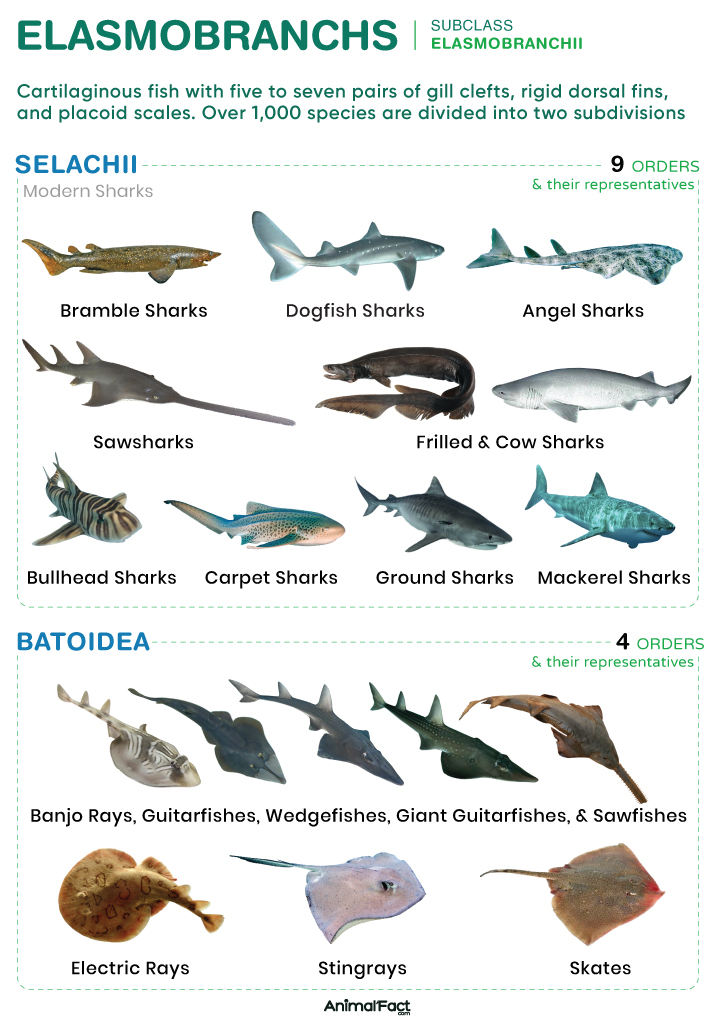
Chondrichthyes - Holocephali
Ratfishes
Upper jaw fused to cranium
Teeth reduced to grinding tooth plates (durophagous habits)
Extended, fleshy operculum covering 4 gill slits
Spiracle absent in adults
Mostly absent placoid scales
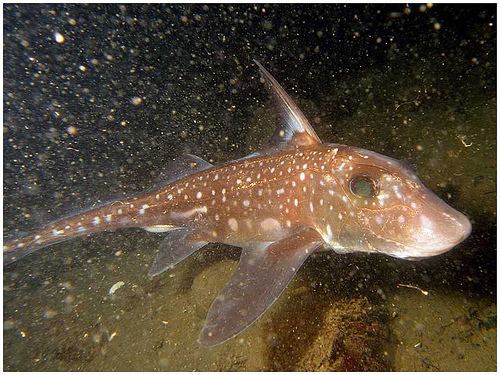
What is the significance of the Greenland shark in regard to vertebrate longevity?
Greenlands are the longest living vertebrates known to science.
They reach sexual maturity at around 156 years of age and grow at a rate of around 1 cm per year. Their metabolisms are extremely slow, and they don’t decline as they get older, unlike other vertebrates.
Lepidotrichia
jointed bony fin rays that surround bundles of giant collagen fibers
True or False: In Osteichthyes, many species retain their cartilaginous endoskeletons.
False; most have well-ossified bony skeletons
Where did the swim/gas bladder in Osteichthyes derive from?
Embryonic tube gut
Many Osteichthyes have mouths that are…
terminal
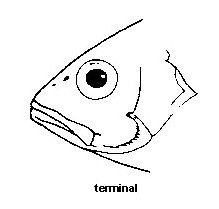
Differentiate between Sarcopterygii and Actinopterygii based on their physical characteristics.
Sarcopterygii
Lobe-finned
Fins monobasal with internal bony elements (mesomeres) and muscles external to the body wall, giving them a fleshy, stalk-like appearance
Cosmoid scales in early members
Actinopterygii
Ray-finned
Endoskeleton, where muscles barely extend onto the fin (if at all)
Ganoid scales in early members; most modern species have reduced, thin elasmoid scales
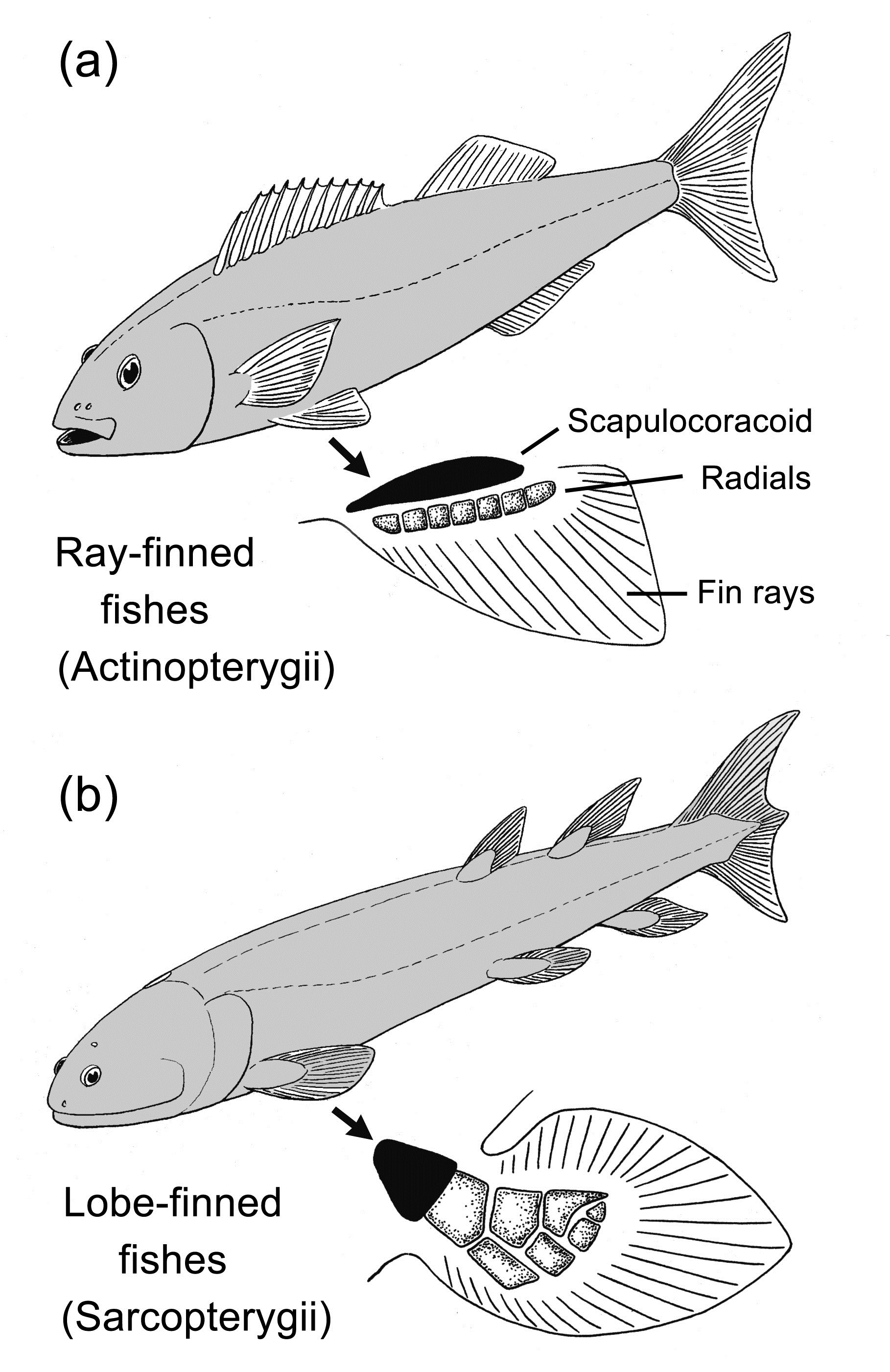
Actinopterygii - Polypteriformes
Bichirs, reedfish
Elongated bodies with heavy rhomboidal scales
Many have lungs
Modified heterocercal tails
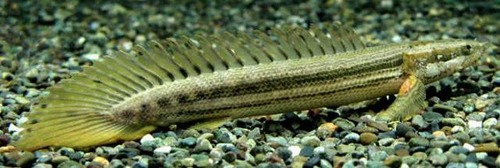
Actinopterygii - Acipenseriformes
Sturgeons, paddlefish
Have spiracles
Secondary cartilaginous skeletons
Most lack ganoid scales (except for sturgeons, which have enlarged scutes in lateral rows along the body)
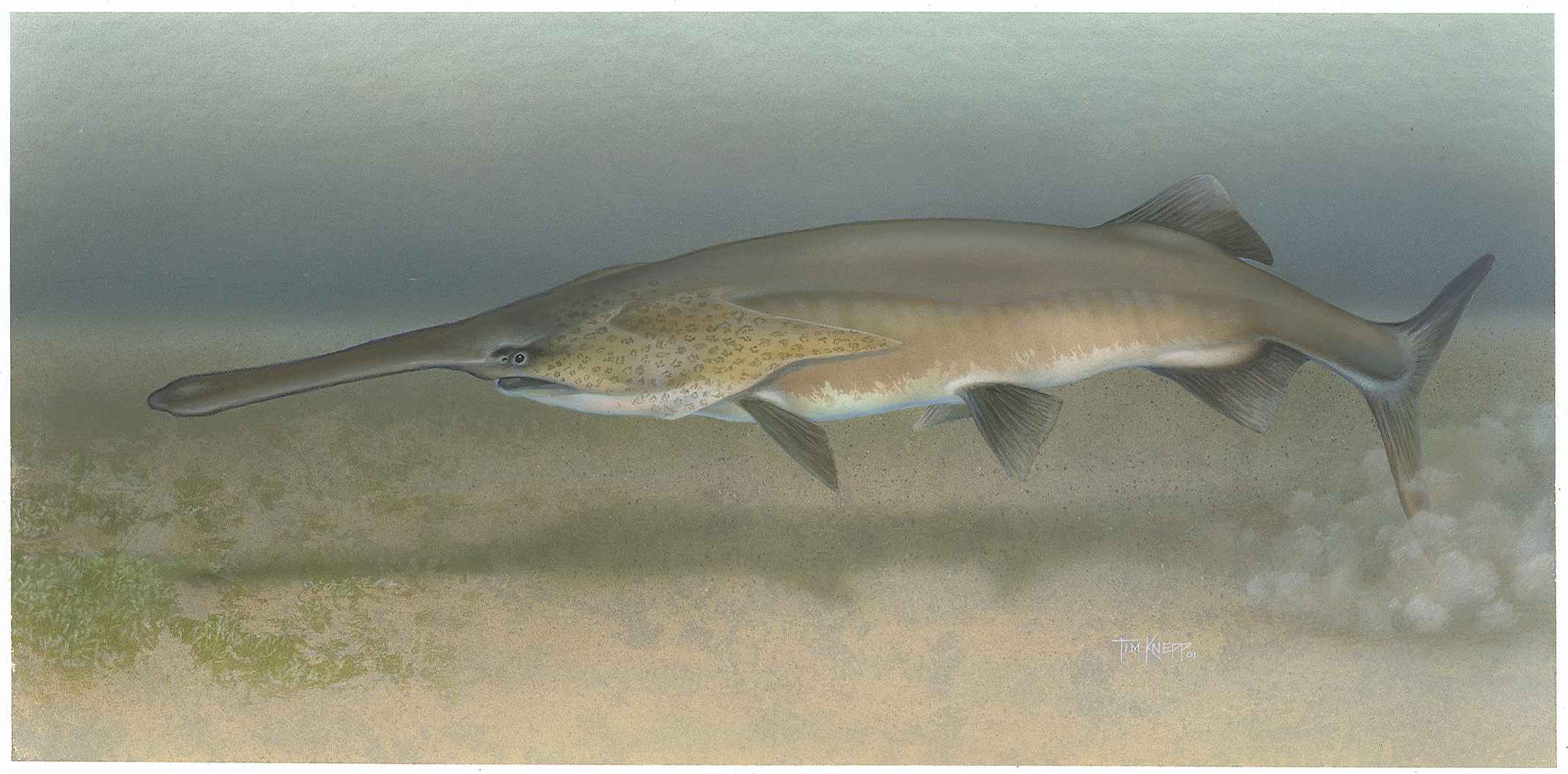
Actinopterygii - Neopterygians
(List the main features.)
Dorsal (rather than ventral) gas bladder
Basals lost from fin skeleton
No spiracle
Reduced heterocercal tail
Loss of electroreceptor ampullary organs
Increased jaw mobility (aka lateral flaring of buccal cavity)
Actinopterygii - Neopterygians - Lepisosteriformes
Gars
Retain large, rhombic ganoid scales
Dorsal gas bladder used for respiration and buoyancy
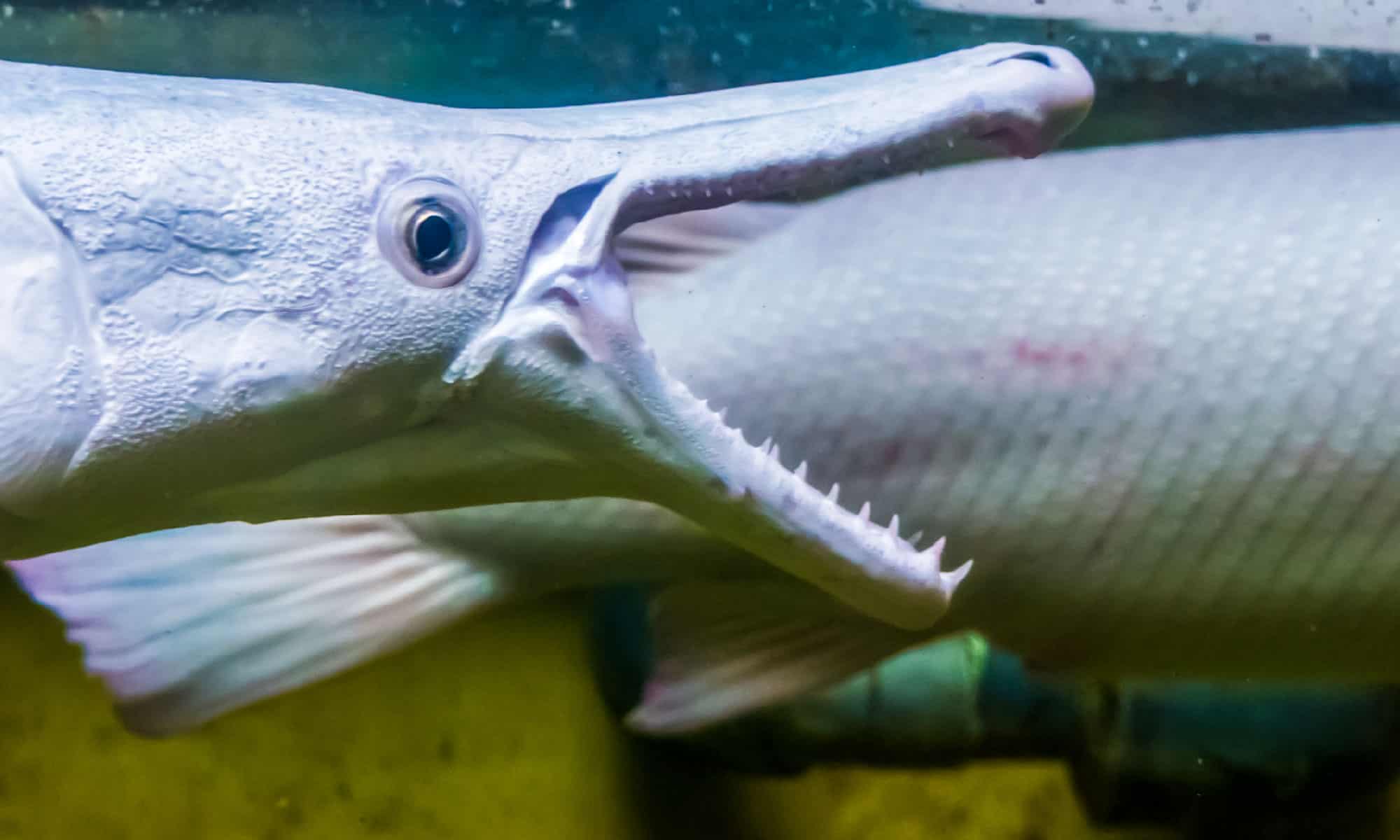
Actinopterygii - Neopterygians - Amiiformes
Bowfin
Dorsal gas bladder used for respiration and buoyancy
Thin scales made of a single layer of bone (like teleosts)
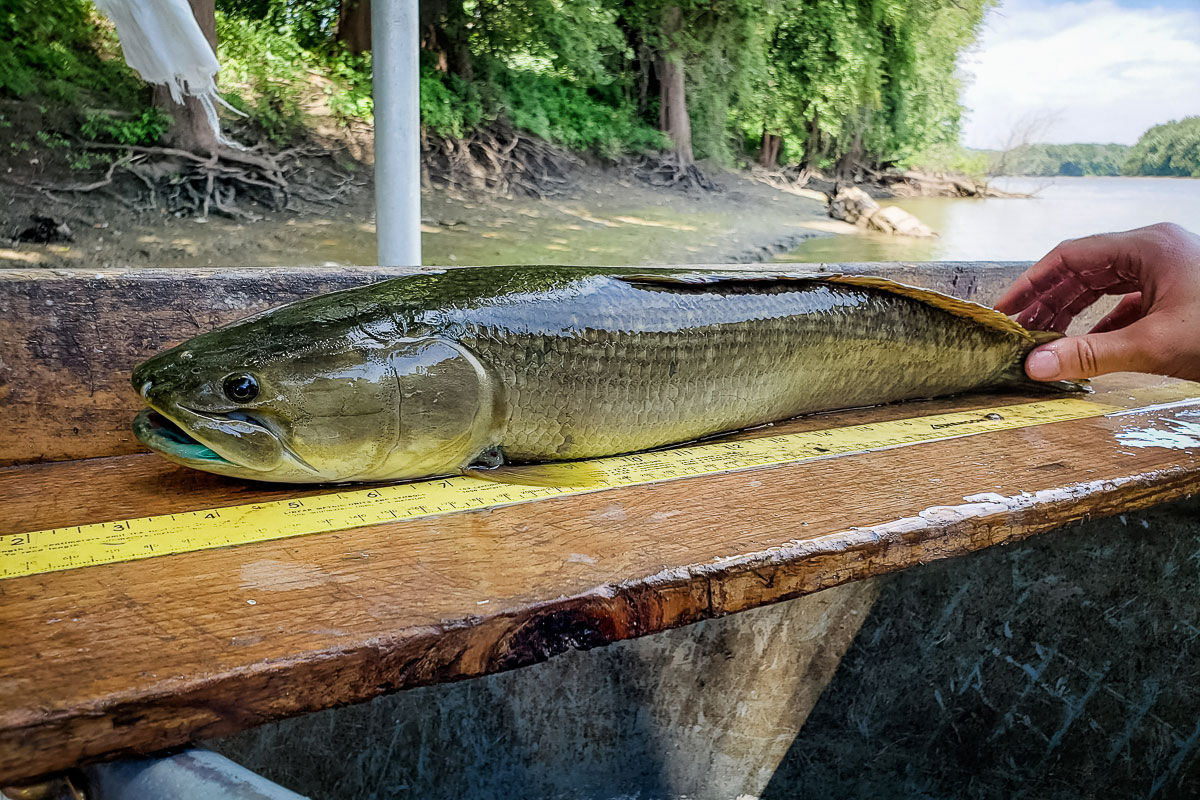
Actinopterygii - Teleosts
(Know the main features.)
Thin, circular elasmoid scales
Ossified vertebrate
Dorsal gas bladder dedicated to buoyancy
Skull with complex jaw mobility
Pharyngeal jaws (see image)
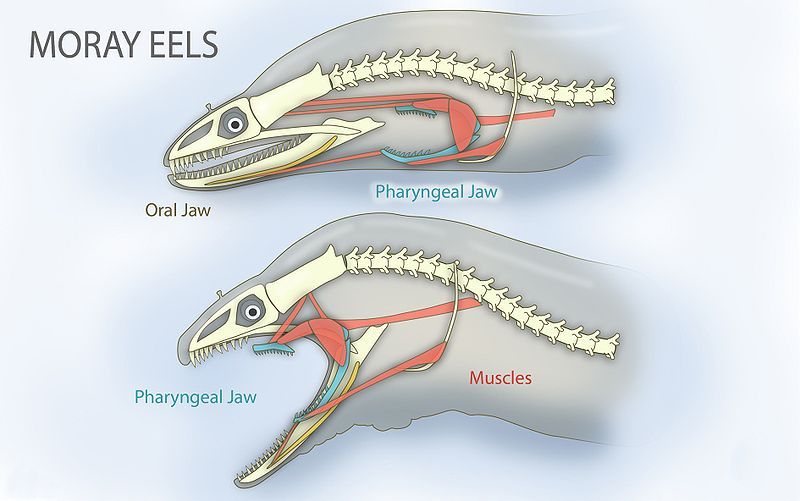
Tetrapods initially emerged from…
tetrapodomorph fishes
loss of bony operculum*
flat head and body, with long snout and dorsal eyes
loss of dorsal and anal fins
reduced tail fins
likely respired via gills and gulping air
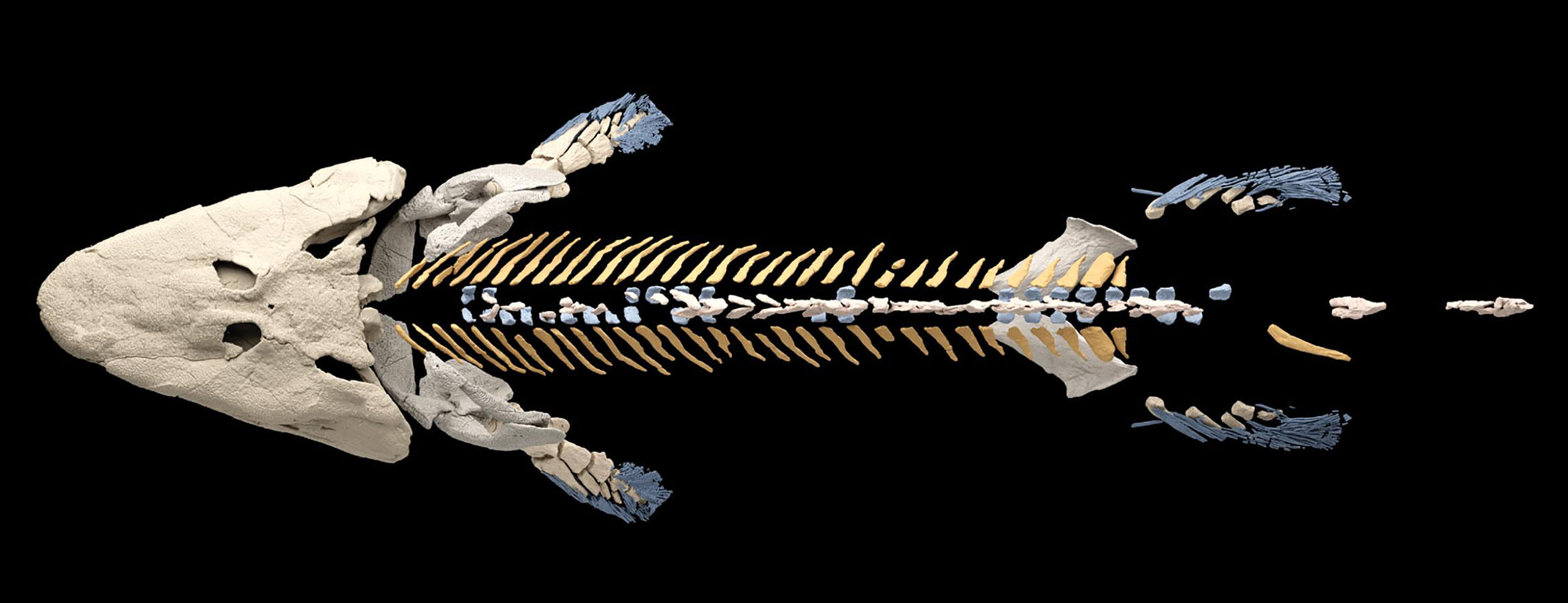
Coelocanths are extant Sarcopterygiians of subclass…
Actinistia
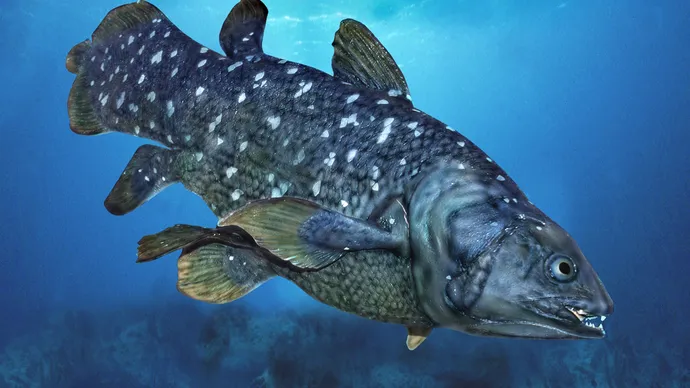
Lungfish are extant Sarcopterygiians from subclass…
Dipnoi
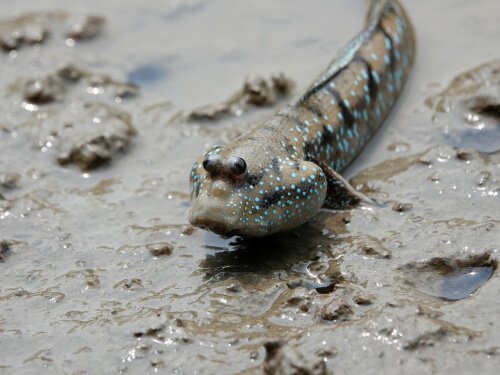
True or False: The earliest tetrapods, such as Acanthostega and Icthyostega, were mostly aquatic, despite having limbs.
True
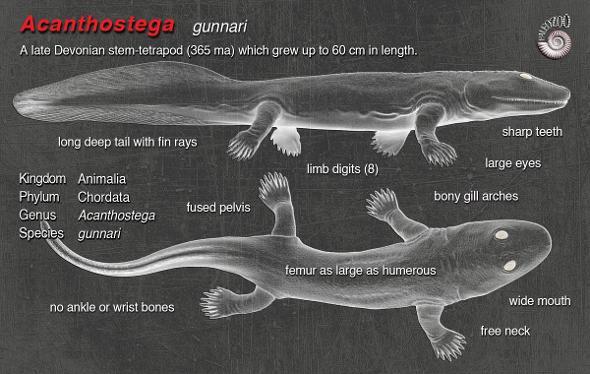
What are the two major lineages of tetrapods?
Lissamphibia
Amniota / Reptiliomorphs
The tetrapod limb consists of supports (girdles) and ______ segments that articulate end-to-end.
5